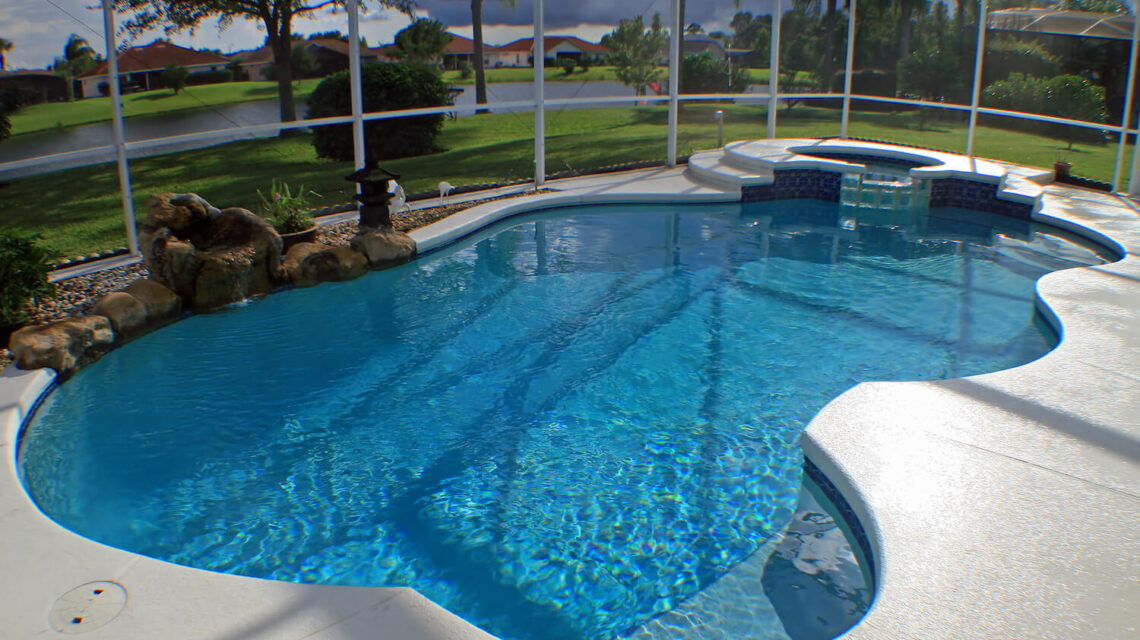A backyard pool is often the focal point of outdoor entertainment, providing a refreshing escape during hot summer days and a picturesque backdrop for gatherings. Over time, however, the wear and tear on your pool’s surface can detract from its aesthetic appeal and functional integrity. Pool resurfacing emerges as a transformative solution, breathing new life into your aquatic haven.
In this article, we will explore the various aspects of pool resurfacing, from its benefits and the materials involved to the process itself and its impact on the overall style of your outdoor oasis.
The Need for Pool Resurfacing
As the seasons change and the years pass, a pool’s surface is exposed to a multitude of elements, including sunlight, chemicals, and fluctuating temperatures. This exposure can lead to visible signs of aging and deterioration, such as cracks, stains, and a roughened texture. Beyond the cosmetic concerns, a deteriorating pool surface can compromise safety and hygiene, making resurfacing a practical necessity.
Signs that Your Pool Needs Resurfacing:
- Cracks and Chips: Small cracks can evolve into major structural issues if left unattended. Resurfacing can address these imperfections, preventing further damage.
- Stains: Stubborn stains caused by minerals, algae, or other factors can be unsightly and difficult to remove. Resurfacing provides a fresh, clean canvas.
- Rough Texture: Over time, pool surfaces may become rough and uncomfortable to the touch. Resurfacing restores the smoothness for a more enjoyable swimming experience.
- Leakage: If you notice a persistent drop in water levels, it could indicate leakage. Resurfacing can help identify and repair leaks, preserving water and preventing damage.
The Benefits of Pool Resurfacing
Investing in pool resurfacing offers a multitude of benefits that extend beyond mere aesthetics. Let’s explore how this process can enhance both the functionality and style of your outdoor oasis.
1. Aesthetic Transformation
Pool resurfacing allows you to reimagine the visual aspect of your pool. Whether you prefer a classic, mosaic-tiled look or a modern, sleek finish, there are various resurfacing materials and designs to choose from, enabling you to customize your pool’s appearance to match your style preferences.
2. Extended Lifespan
By addressing minor issues early on through resurfacing, you can significantly extend the lifespan of your pool. This proactive approach prevents small problems from escalating into major structural issues, saving you time and money in the long run.
3. Enhanced Safety
A smooth, well-maintained pool surface reduces the risk of injuries, such as cuts and abrasions. Resurfacing also allows for better visibility of the pool floor, promoting a safer swimming environment.
4. Improved Hygiene
Old, deteriorating pool surfaces can harbor bacteria and algae, compromising water quality. Resurfacing not only revitalizes the appearance but also contributes to a healthier swimming environment by creating a smooth, non-porous surface that is easier to clean and maintain.
5. Increased Property Value
A beautifully resurfaced pool enhances the overall appeal of your property. Should you decide to sell your home, an upgraded pool can be a significant selling point, attracting potential buyers and potentially increasing the resale value of your property.
Resurfacing Materials and Options
When it comes to pool resurfacing, the choice of materials plays a crucial role in achieving the desired aesthetic and functional outcomes. Here are some popular resurfacing materials and options to consider:
- Plaster: Plaster is a classic and cost-effective choice for pool resurfacing. It provides a smooth finish and comes in various colors, allowing for customization. However, plaster may not be as durable as some other options and may require more frequent maintenance.
- Pebble Tec: Pebble Tec is a durable and visually appealing option that incorporates small, smooth pebbles into the surface. This creates a textured finish that not only looks stunning but also adds traction, making it a practical choice for pool areas.
- Tiles: Tiled surfaces offer a wide range of design possibilities. From mosaic patterns to solid colors, tiles provide a sleek and customizable finish. They are also resistant to staining and provide a smooth surface. However, tiles may be more expensive than other resurfacing options.
- Aggregate Finishes: Aggregate finishes involve mixing materials like quartz, glass beads, or pebbles with plaster to create a unique, textured surface. This option combines durability with a visually appealing finish, offering a middle ground between traditional plaster and more intricate finishes like Pebble Tec.
The Pool Resurfacing Process
Understanding the pool resurfacing process is essential for homeowners considering this transformative endeavor. While specific steps may vary depending on the chosen resurfacing material, the general process involves the following key stages:
1. Surface Preparation
Before applying the new surface material, it is crucial to prepare the existing pool surface. This involves draining the pool, removing any old finishes, and addressing any structural repairs that may be needed.
2. Application of Bonding Agent
To ensure proper adhesion of the new surface material, a bonding agent is applied to the prepared pool surface. This agent creates a strong bond between the existing structure and the new resurfacing material.
3. Application of Resurfacing Material
The selected resurfacing material is applied to the pool surface, whether it be plaster, Pebble Tec, tiles, or aggregates. This stage requires precision and expertise to achieve a smooth and uniform finish.
4. Curing and Finishing
Once the resurfacing material is applied, it undergoes a curing process to ensure durability. After curing, the pool is filled with water, and finishing touches are applied to perfect the appearance and texture of the surface.
5. Filling and Balancing
The final step involves filling the pool with water and balancing the water chemistry to ensure optimal conditions for swimming. Proper maintenance practices are then established to preserve the newly resurfaced pool.
Budget Considerations
The cost of pool resurfacing can vary significantly based on factors such as the chosen material, the size of the pool, and any additional repairs needed. While it may seem like a substantial investment, it is important to view pool resurfacing as a long-term enhancement that contributes to the value and enjoyment of your property.
Factors Affecting Cost
- Size of the Pool: Larger pools require more materials and labor, impacting the overall cost of resurfacing.
- Chosen Material: The cost of materials varies, with options like tiles and Pebble Tec generally being more expensive than traditional plaster.
- Additional Repairs: If your pool requires structural repairs or fixes to the plumbing system, these additional tasks can contribute to the overall cost.
- Geographical Location: Labor and material costs can vary based on your geographical location and the availability of skilled professionals.
Maintenance Tips for a Lasting Splash of Style
Having invested in pool resurfacing, it’s crucial to adopt a proactive approach to maintenance. By incorporating a consistent maintenance routine, you can ensure that your newly resurfaced pool remains a stunning and functional asset to your outdoor space.
1. Regular Cleaning:
- Skimming and Vacuuming: Keep the pool free of debris by skimming the surface regularly. Additionally, use a pool vacuum to remove dirt and particles from the pool floor.
- Tile Cleaning: If you opt for tiled surfaces, regularly clean the tiles to prevent the buildup of grime and algae. Use a mild cleaner and a soft brush to maintain the tiles’ luster.
2. Water Chemistry:
- Balancing pH Levels: Regularly test and adjust the pH levels of your pool water. Balanced pH ensures the effectiveness of pool chemicals, prevents corrosion, and contributes to the longevity of the resurfacing material.
- Chlorine and Sanitization: Maintain proper chlorine levels to keep the water sanitized. This helps prevent the growth of algae and bacteria that could compromise the appearance and safety of the pool.
3. Addressing Wear and Tear:
- Prompt Repairs: Attend to any cracks or chips promptly. Quick repairs prevent further damage and ensure that your pool remains structurally sound.
- Inspect Equipment: Regularly inspect and maintain pool equipment, such as pumps and filters, to prevent malfunctions that could affect water circulation and quality.
4. Seasonal Considerations:
- Winterization: If you live in a region with cold winters, winterize your pool to protect it from freezing temperatures. Proper winterization prevents damage to the resurfacing material and other pool components.
- Summer Preparations: Prepare your pool for the summer season by removing winter covers, checking equipment, and ensuring that the water chemistry is balanced.
5. Professional Inspections:
- Periodic Checks: Schedule periodic inspections by a professional pool service. This allows experts to identify potential issues early and provide recommendations for maintenance and repairs.
- Renew Resurfacing as Needed: Over time, even the best resurfacing materials may show signs of wear. Depending on the material used, plan for periodic resurfacing to keep your pool in top condition.
The Timeless Appeal of a Resurfaced Pool
In the realm of home improvements, few projects can match the transformative impact of pool resurfacing. Beyond the immediate visual enhancement, resurfacing contributes to the longevity and functionality of your pool, ensuring it remains a valuable asset for years to come.
By selecting the right resurfacing material, adhering to a diligent maintenance routine, and complementing your pool with thoughtful landscaping and amenities, you can create an outdoor oasis that reflects your style and becomes a haven for relaxation and socializing.
Remember, a resurfaced pool is not just an aesthetic upgrade; it’s an investment in the well-being of your property and the enjoyment of your outdoor space. So, splash into style, embrace the rejuvenating effects of pool resurfacing, and let your outdoor oasis become a timeless retreat for you, your family, and your friends.
Conclusion
In conclusion, pool resurfacing is a transformative investment that goes beyond mere aesthetics, contributing to the longevity, safety, and functionality of your outdoor oasis. Whether you opt for the classic appeal of plaster, the textured luxury of Pebble Tec, or the customizable elegance of tiles, the resurfacing process allows you to tailor your pool to match your unique style preferences.
As you consider the benefits and materials available, it’s important to recognize that pool resurfacing is not just a one-time project but a commitment to the ongoing care and maintenance of your pool. With the right choices and proper upkeep, your resurfaced pool will continue to be a stunning centerpiece, inviting friends and family to splash into style in your revitalized outdoor retreat.




